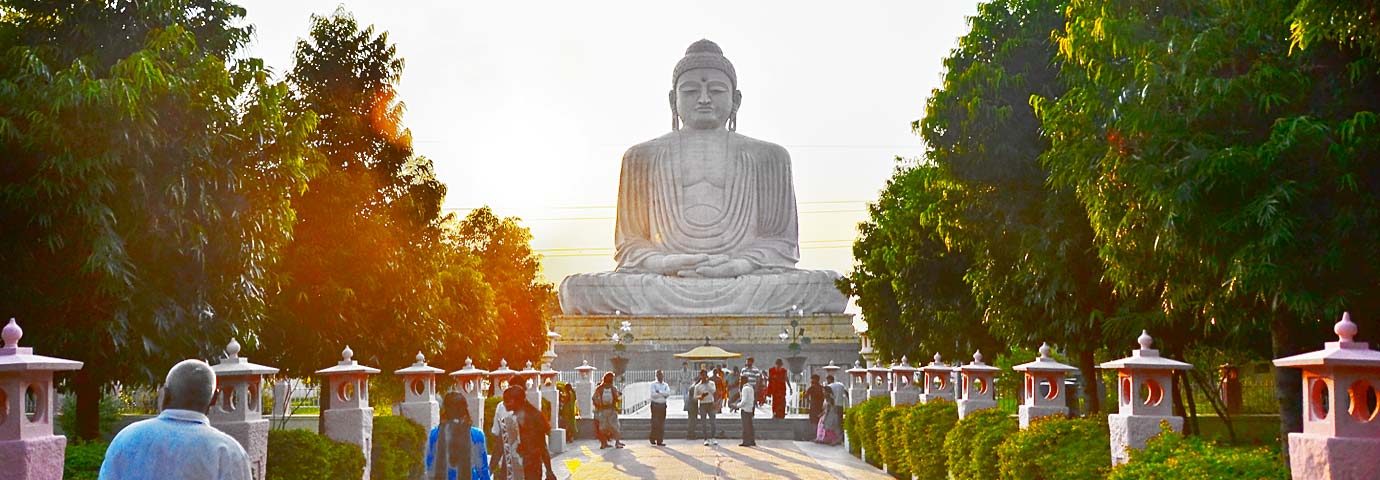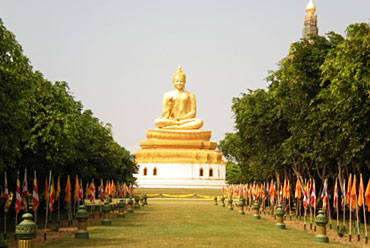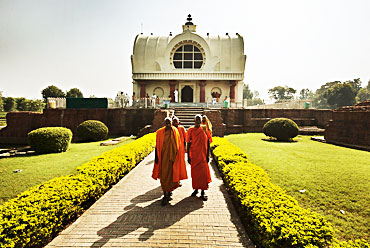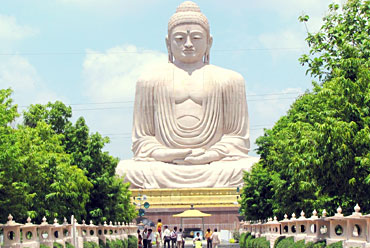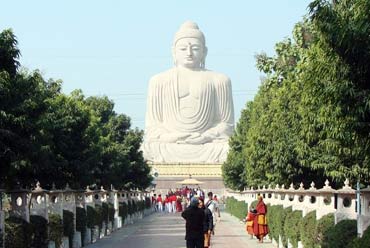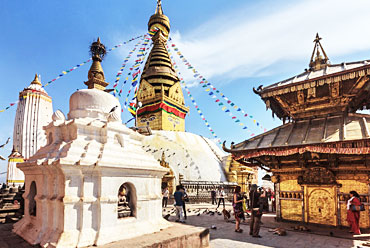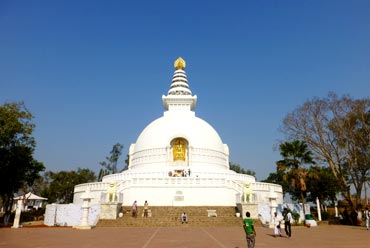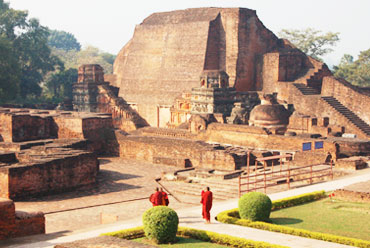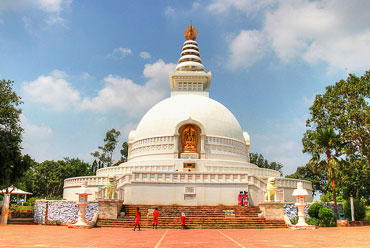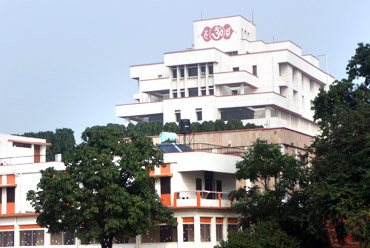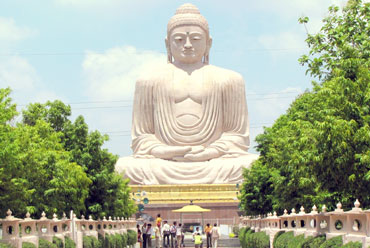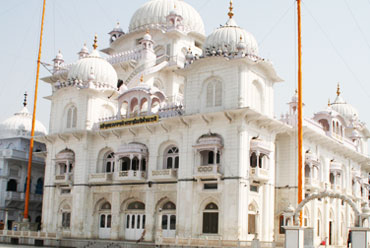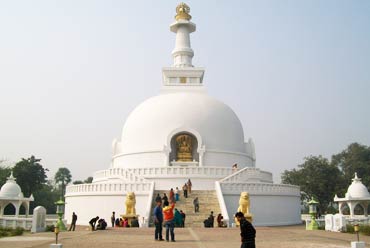Bihar, an eastern Indian state and the place that gave birth to Buddhism and Jainism and helped in the growth of Sikhism and Hinduism, has a past that is unmatched anywhere in the world. It was the center of first republic in the world at Vaishali and the city of Patliputra was largest and grandest in the world at the height of its glory. Even today, the state is the largest mineral producing region in India and contributes immensely in national wealth creation. There is an array of tourist destinations of diverse interests in the state, though their potential has not been exploited fully till now. The state that represents every thing good and bad within the country is waiting to be explored and rediscovered.
Location
Bihar is located in the eastern region of India, bordering Nepal in the North, West Bengal in the east, Uttar Pradesh in the West, and Madhya Pradesh and Orissa in the South. Bihar lies between the latitudes 21°58' and 27°31' North and longitudes 83°19' and 88°17' east.
Bihar can be divided into three distinct regions i.e. the north Gangetic plains, Central Bihar, and South Bihar plateau. The North Gangetic plain is an extension of the Terai region of Nepal with many tributaries of the Ganges like Kosi, Gandak, Baghmati, and Kamla Balan flowing through it. It is a flood prone region and one of the most backward regions in the country. Central Bihar, south of the Ganges, is a region with rich agricultural resources. The South Bihar plateau is the largest mineral-producing region in the country with some of the best-known industries in the country like TISCO, TELCO, Bokaro Steel Plant, and Heavy Engineering Corporation having their base here. Most of the north and central Bihar is plain has no significant elevation.
History
The early history of Bihar is lost as the major events and happenings were not documented but with the advent of Jain and Buddhist texts documentation of events began. And from these texts we get to know about the sixteen Mahajanapadas that flourished during the 6th century BC. Vaishali, Anga, Rajgriha, Pataliputra, Nalanda, and Mithila are just a few of the places in Bihar that knit the history of ancient India.
Vaishali in northern Bihar, the center of the Lichchavi kingdom is rated as the most ancient and credited as the world's first republic. It got its aura of sanctity with the birth of Lord Mahavira here. This was also the favorite resting place of Lord Buddha and he preached his last sermon here, which was later commemorated by a lion capital erected by King Ashoka. The legends of the courtesan Ambapali's exquisite beauty added to the glory and charm of Vaishali.
By the fifth century BC, the focus of history shifted to Magadh with its capital at Rajgriha (seen as the first recorded capital in Indian history), and later Pataliputra. Rajgriha witnessed the first Buddhist Council and the conversion of the Mauryan king Bimbisara to Buddhism. During the last days of the Buddha, the political masters thought of shifting their capital from Rajgriha to Pataliputra, which gradually became the pride of Asia and subsequently the capital to the great empires of Nandas, Mauryas, Sungas and Guptas. It was here that Megasthenes spent most of his time as an Ambassador of his Syrian king Seleukos Nikator.
During the medieval period, except for the brief twinkle of Sher Shah's reign who rose from his base in Bihar to the sultanate of Delhi that ruled over the entire country, the province of Bihar rarely enjoyed the status of an independent state; rather it swayed with the fortunes of Delhi, Jaunpur and Bengal. Various sultans of Delhi and later the Mughals, as well as emperors and princes, criss-crossed Bihar in order to crush the rebellions in distant Bengal.
Much later, Babur, in pursuit of the Lodhis, came as far as Bihar. Babur's death brought Humayun to the throne of Delhi and he had a hard time fighting his Afghan adversary from Bihar, Sher Shah. Most of their decisive battles were fought in and around Bihar. Sher Shah was more than a match for Humayun and gradually he paved his way to the throne of Delhi. During his brief reign of five years, Sher Shah proved himself to be one of the greatest rulers of medieval India.
After the coming of the British to India, Bihar again played an important role in deciding the future course of the country and Buxar became the place where the final battle for supremacy in north India was fought between the East India Company and the combined forces of the Mughals, and Nawabs of Bengal and Awadh in 1764.
Bihar was part of the Bengal presidency till 1911, when a separate province comprising Bihar and Orissa was created. In 1936, Bihar was made an independent province.
Apart from the documented history, Bihar finds mention in the legends and tales related to the Ramayan. It is believed that the Goddess Sita, the wife of Lord Ram, was born in Mithila to King Janak, the ruler of the region.
Tourist Attractions in Bihar
Patna is a city abounding in the relics of the bygone ages. Takht Harmandir Saheb is of religious importance to the Sikhs and is believed to be the place of birth of the last Sikh guru, Govind Singh. The Jalan Museum with a rare collection of curios. Sher Shah's mosque in the heart of the city is a splendid example of Afghan architecture. Among the numerous mosques in Patna, Begum Hajjam's mosque stands as the oldest. Saif Khan's Madarsa mosque, built in 1630, commands a magnificent view of the riverfront. Saif was married to Malika Bano, the elder sister of Mumtaz Mahal, the wife of emperor Shahjahan. Excavations at Kumhrar have yielded the remains of a Mauryan palace with sandstone pillars. One can still see Agam Kuan or the fathomless well, which was part of Ashoka's hell for prisoners. The famous Mahendru Ghat in today's Patna is the reminder of Mahendru (Ashoka's brother) who had sailed from this very Ghat to Ceylon in order to preach Buddhism. The Khuda Baksh Oriental library is a treasure trove of medieval manuscripts. The Patna Museum is noted for its collection of statues and a very old fossilized tree, 16 meters high. Close to the museum is the Gol Ghar, the 29 meter high beehive shaped granary constructed in 1786, following a terrible famine. The Patna Cemetery is a historically important European monument situated in what was once a Haveli (mansion) and is now a hospital. Some distance from the cemetery is the Padri ki Haveli, a Catholic church with an imposing façade.
Thirty kilometers from Patna is Maner, a medieval stronghold of the Turks and the site of the shrines of Hazrat Makhdum Yahya Maneri and his son Shafruddin Ahmed Maneri.
The remains of an ancient fort with massive cyclopean walls together with other sites amidst lush green surroundings of Rajgriha recreate the glory of the past. Until the discovery of Mohenjodaro and Harappa, this was believed to be the oldest architectural remains in India. The site is equally revered by the Jains, as their 24 Tirthankars are believed to have practiced austerities on the different hills of Rajgriha. The Jal Mandir at Pawapuri (the sinless city) marks the site where Vardhamana Mahavira (the 24th Tirthankar) was cremated while Parasnath hill is associated with the Nirvana of the 23rd Tirthankar, Sri Parsvanath.
Nalanda, in the heart of Bihar, stands as the world's most ancient seat of learning. The ruins confirm the university's ability to cater to the needs of 10,000 students until the 12th century AD. The excavations have yielded numerous monasteries, temples, stupas and statues of Buddha. The Vikramshila University was an important institution of Tantric Buddhism and there was a regular exchange of teachers between the two universities.
Bodh Gaya houses the site of the sacred Mahabodhi tree where the Buddha attained enlightenment. Adjoining the tree is the high-spired Mahabodhi temple considered to be the most sacred shrine for Buddhists. Add to this the Hindu legend of Gaya, which was the name of a demon that grew so powerful that the gods felt threatened. As a pre-condition to his death, he demanded that the area covered by his body should be one of the holiest spots of the world. This land is believed to be Gaya.
Rajmahal is a medieval settlement on the eastern fringe of Bihar. It is believed to have been founded by Raja Man Singh, the Rajput general of Emperor Akbar. It was earlier a strategic place for the Bengal sultans who pitched their advance tent here before moving on to any military campaign.
The picturesque mausoleum of Sher Shah at Sasaram, outdoes the Taj Mahal in size, with a dome that surpasses it by 13 feet. Also at Sasaram we find the mausoleum of Sher Shah's father, Hasan Shah Sur. No less picturesque is the tomb of Sher Shah's son, Salim Shah, built in the center of a lake. On the outskirts of the village is the tomb of Aliwal Khan, the chief architect working for Sher Shah. A few hours' drive from Sasaram takes one to the Rohtasgarh fort. In the words of Abul Fazal it is "a well defended paradise (fort) with no equal for strength and solidity." The fort, 28 miles in circumference, is a perfect platform for eco-tourism projects. It is perched high on the Kaimur hills and there are abundant springs and numerous monuments that bring to life the history of its Mughal and Afghan governors and still later the Britishers who almost destroyed the surviving parts.
The Chotanagpur plateau spread over 34,000 square miles that encompass the southern half of Bihar, is one of the most fascinating places in India. There is no end to scenic attractions, waterfalls, deciduous forests, hills (rising up to 3,000 feet), plateaus (at an elevation of 1,000 feet), valleys, wildlife, and of course the aboriginals, who predominate this region. Add to this the salubrious climate that makes the region an ideal getaway.
The oldest geological formation of India are found in the Chotanagpur plateau of Bihar that also stores a vast deposit of a variety of minerals that cater to national and international needs. Bihar, on an average accounts for half the total output of coal and mica, the whole of copper and about 45 per cent of the iron produced in India. It is also the only region in the country to have Uranium mines.
Prominent places in Chotanagpur include Ranchi (2,140 feet), a picturesque hill station that inspired Tagore to compose a book of poems; Netarhat or the 'queen of Chotanagpur' is perched at 3,700 feet and offers beautiful sunset and sunrise views; Palamau is famous for its tropical forest and is rich in wildlife, and is the place where the world's first tiger census was conducted in 1932. As of today, there are 45 tigers in the reserve and they are now said to be venturing out in search of new territories. No less interesting is the Hazaribagh Wildlife Sanctuary nestling at a low terrain (1,800 feet). Hazaribagh is also vying for a place in the international heritage list for its recent findings of rock paintings, caves, stone age tools and smelted iron slag that shows a much early advent of the Iron Age than the theorized Chalcolithic age. At another village in Hazaribagh, the archaeologists have unearthed densely packed layer of pottery shards that are identical to those found at Harappa.

